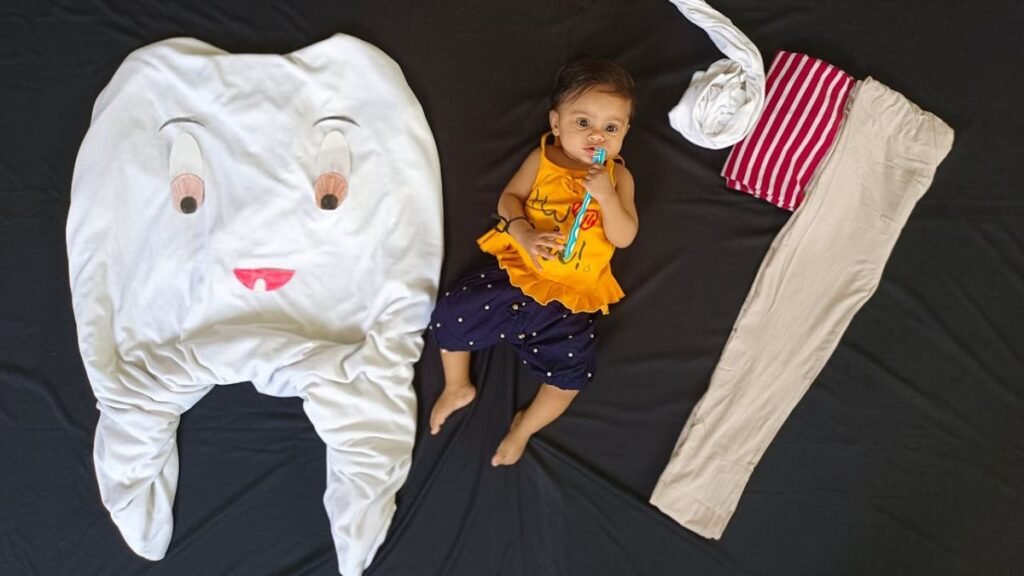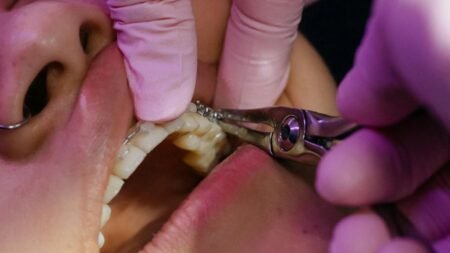“A baby’s smile is an angel’s whisper to the heart.” – Terri Guillemets
As a new parent, I’ve learned that teething is a big deal. It starts between 6 to 10 months and can last until 33 months. Knowing when it starts and ends is key for caregivers.
I found out that babies get their first teeth between 6 to 10 months. Then, more teeth come in pairs every 2 to 4 months. By age 3, they should have 20 primary teeth.
Some babies start teething as early as 4 months, while others might wait until 15 months. This is normal and not a worry. The American Academy of Pediatrics says to take your baby to the dentist by their first birthday or when they get their first tooth.
Understanding the Teething Process in Babies
As a parent, I’ve learned that teething is a big milestone in a baby’s life. It’s when their tiny baby teeth start to come in. This is often followed by symptoms that can be tough for both babies and parents.
What is Teething and When It Begins
Teething happens when a tooth comes through the gums. Babies start teething at different times, usually between 4 and 7 months. Some might start as early as 3 months, while others might not see their first tooth until closer to their first birthday.
Normal Age Ranges for First Tooth Appearance
The first teeth to appear are usually the bottom front teeth, or lower central incisors. These teeth usually come in around 6 months of age. Then, the upper front teeth come in between 9 and 16 months. By their third birthday, most children have all 20 of their primary teeth.
Early and Delayed Teething Cases
Every child teethes at their own pace. Some might start teething as early as 3 months, while others might not see their first tooth until after 12 months. If you’re worried about your baby’s teeth, it’s good to talk to a pediatric dentist. Remember, if your child’s teeth come in early or late, it might just be in their genes. This usually means there’s nothing to worry about.
| Teething Stage | Age Range | Teeth Appearing |
|---|---|---|
| Early | 3-5 months | Lower central incisors |
| Average | 6-12 months | Lower and upper central incisors |
| Late | 12-15 months | First molars |
How Long Does Teething Last
Teething is a big step in a baby’s life. I’ll show you the timeline of teething, from the first tooth to the last. This will help you know what to expect during this time.
Complete Timeline from First to Last Tooth
Teething usually starts when a baby is 4 to 7 months old. It goes on until they are 2 to 3 years old, when they have all 20 primary teeth. Teeth come in pairs, with a new set every 2 to 4 months.
Order of Tooth Eruption
Teeth come out in a certain order. Here’s when they usually appear:
| Tooth Type | Age Range |
|---|---|
| Lower central incisors | 6-10 months |
| Upper central incisors | 8-12 months |
| Upper lateral incisors | 9-13 months |
| Lower lateral incisors | 10-16 months |
| First molars | 13-19 months |
| Canines | 16-22 months |
| Second molars | 23-33 months |
Duration of Individual Tooth Breakthrough
Each tooth takes about 1 to 7 days to come through the gum. The pain of teething usually lasts a few days before and after the tooth comes out. So, the whole process for each tooth can take up to two weeks.
It’s key to remember that while teething can be uncomfortable, it shouldn’t cause serious problems like high fever or diarrhea.
Common Teething Symptoms and Signs
Teething is a big step in a baby’s growth. Each baby shows teething in their own way. Knowing the signs can help you comfort your baby during this tough time.
Drooling is a clear sign of teething. You’ll see your baby’s chin and clothes always wet. This can cause rashes on their mouth and neck.
Sore gums are another sign. Babies often chew on things or their fingers to feel better.
Babies might get irritable and fussy when teething. They can be cranky, even at night. Some may have a low fever, but if it’s over 101°F, see a doctor.
- Cheek rubbing and ear pulling
- Changes in eating habits
- Difficulty sleeping
- Mild diarrhea (due to increased saliva swallowing)
Not all babies show the same teething signs. Some might not feel much pain, while others do. If you’re worried about your baby’s symptoms, talk to your pediatrician.

Safe Teething Relief Methods and Treatments
Managing teething discomfort can be tough for babies and parents. But, there are safe and effective ways to make it easier. The right approach can help make this time more bearable.
Recommended Teething Toys and Tools
Teething toys are a great relief. Rubber teething rings chilled in the fridge are very helpful. They cool sore gums.
Soft, textured teething toys are also good. They let babies chew safely.
Natural Remedies for Teething Pain
Gently massaging your baby’s gums with a clean finger can help. A cold washcloth is also soothing for them to chew on.
Frozen fruit in a mesh feeder is another option. It’s a healthy snack and comfort all in one.
Over-the-Counter Treatment Options
For severe pain, acetaminophen (Tylenol) is sometimes used. Always follow the dosage instructions. Ibuprofen is okay for babies over 6 months, but check with your doctor first.
Unsafe Remedies to Avoid
Stay away from harmful teething remedies. Topical gels with benzocaine are dangerous. Homeopathic teething tablets and jewelry are also risky.
It’s best to talk to a pediatric dentist or pediatrician before trying new remedies. Every baby is different. What works for one might not work for another. The goal is to find safe, effective ways to help your baby while keeping them comfortable and safe.
Conclusion
Teething is a big part of a baby’s growth. It starts around 6 months and can last up to 3 years. Every baby is different, with some starting earlier or later.
Managing teething discomfort is important for both babies and parents. Signs include more drooling, being irritable, and swollen gums. Safe ways to help include teething toys and cold foods. Always avoid unsafe remedies and get advice from a pediatric dentist.
Teething is just a temporary phase. With patience and the right care, your baby will get through it easily. It’s important to take your baby to the dentist regularly, starting from the first tooth or by their first birthday. Knowing the timeline and symptoms helps you support your child during this important time.
FAQ
When does teething typically start and end?
Teething starts around 6 to 10 months old. It lasts until 25 to 33 months. Babies usually get their first teeth between 6 and 10 months. By age 3, they have 20 primary teeth.
What are the most common signs of teething?
Signs include more drooling, being irritable, and wanting to chew on things. But, every baby is different. Some may not show any signs.
In what order do baby teeth typically appear?
Teeth come in this order: lower front teeth, upper front teeth, upper side teeth, lower side teeth, first molars, canines, and second molars. Teeth come in pairs, every 2 to 4 months.
How long does it take for each tooth to fully emerge?
It takes about a week for each tooth to come out. You might feel discomfort a few days before and after.
What are some safe teething relief methods?
Safe ways include teething toys, cold washcloths, and gum massages. For over 6 months, acetaminophen or ibuprofen might help with pain, under a doctor’s advice.
Are there any teething remedies to avoid?
Yes, avoid benzocaine gels, homeopathic remedies with belladonna, and teething jewelry. Always check with a pediatric dentist or doctor before using any remedies.
When should a child have their first dental visit?
The American Academy of Pediatrics suggests the first dental visit by the first tooth or by 1 year, whichever comes first.
Can teething cause diarrhea?
No, experts say diarrhea is not a sure sign of teething anymore. If your baby has persistent diarrhea, see your pediatrician.
Is it normal for teething to start as early as 4 months or as late as 15 months?
Yes, teething can start between 6 to 12 months. But, it can start as early as 4 months or as late as 15 months. Timing can run in families.
How can I tell if my baby’s teething discomfort is severe?
Some discomfort is normal, but severe pain, fever, or other symptoms are not typical. If worried, talk to your pediatrician.








